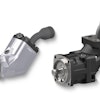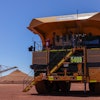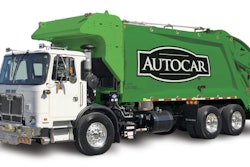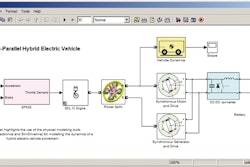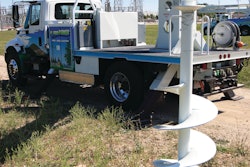
On November 5th, 2009, EnerDel Inc., Indianapolis, IN, a subsidiary of Ener1 Inc., announced it would be working with the U.S. Army to develop a next-generation battery system for the XM1124 hybrid HMMWV (high mobility multi-purpose wheeled vehicle) or Humvee. The company received a $1.29 million contract to design and build high-performance lithium-ion battery systems for two different applications.
EnerDel Inc. designs and manufactures lithium-ion battery systems and strives to develop renewable clean energy systems to ensure the reduction of oil consumption and greenhouse gases.
For the XM1124 Humvee “we only have responsibility for the battery system, which is the cells themselves and all of the battery management system (BMS),” explains Adam Hunt, manager of government programs, EnerDel Inc.
EnerDel is currently collaborating with the U.S. Army Tank Automotive Research, Development and Engineering Center (TARDEC) located in Warren, MI, to produce four custom-built power systems that will be subjected to extreme performance simulations. The XM1124 vehicle is located in Huntsville, AL, subcontracted to DRS Technologies, which performs the vehicle performance testing.
TARDEC will be testing two of EnerDel’s battery chemistries. “The mixed oxide hard carbon is the first pack that’s going to go out,” explains Hunt. “It’s a PHEV cell. That one is first because the cell is production ready and can tolerate high C-rate discharges, which the Army was looking for.”
The program will also test EnerDel’s lithium-titanate system, an advanced chemistry developed in collaboration with Argonne Natl. Laboratory in Chicago, for extreme high-power hybrids that require hard acceleration and braking.
“The hard carbon battery chemistry didn’t meet the Army’s requirements for the second pack, so the titanate cell was chosen but was not currently available in the form factor that they wanted for this pack. We’re working on making the larger version of the titanate cell so that it can go into the second deliverable, which should be Q4 of this year,” says Hunt.
The hybrid Humvee platform has been around for years and is considered a “mule” platform, meaning it is strictly a research platform, not one that is released to the operating units of the military.
The parameters given to EnerDel were a standard operating voltage between 270 and 325 volts with the highest capacity possible in the volume allowed. The battery system has to weigh less than 400 kg.
The U.S. Army also gave discharge requirements. The first battery technology (hard carbon) pack has to be capable of a 500 amp discharge. The discharge current for the titanate chemistry is higher, but the exact values are unable to be disclosed.
The goals of the hybrid Humvee program were to increase fuel economy without loss of performance and increase the peak power capability. The hybrid platform is being compared against the standard M1113 Humvee—a diesel, automatic transmission, four-wheel-drive vehicle. The XM1124 Humvee is already more efficient than the conventional M1113, boasting a higher top speed, faster acceleration, longer range and improved fuel economy.
“The XM1124 uses a diesel generator with electrical motors at the front and rear. Its still four-wheel drive, but the diesel doesn’t have any power transmission directly to the ground. It’s only function is to act as a charger. They want to use the battery to drive the vehicle with and without the diesel operating,” explains Hunt.
“The Army wants the vehicle to be able to sit for a long period of time with running electronics, then have a certain distance they can drive on battery energy alone without starting up the generators. It limits the thermal and audible signatures allowing them to operate without detection.”
Challenges and limitations
The thermal management system has proven challenging for EnerDel, as the military extends the cold weather and high temperature performance parameters so the vehicle can operate anywhere in the world. “Spreading the battery system’s capability across the entire military temperature operating range has been the challenge to monitor thus far,” Hunt says.
EnerDel is solving that problem by designing a self-contained thermal management system, which adds space constraints and uses energy, which comes at a premium. The BMS must not only control all of the battery functions—charge, discharge and balancing—but now also thermal control of the cell.
A requirement in relation to the battery’s maximum intake of current was regenerative braking. Typically quick charges have had lower retention percentages. With regenerative braking, there is a lot of energy coming into the system at a very high current over just a few seconds. That energy must be able to be stored retained without losing it or burning it off as heat.
EnerDel’s lithium-titanate cell will allow the battery system to do just that: easy charge acceptance with high power discharge capabilities.
More vehicles, technology from TARDEC
The U.S. Army Tank Automotive Research, Development and Engineering Center (TARDEC) and Michigan’s growing defense industry will receive more than $14 billion in federal funds to pursue military and energy projects. Some of these technologies headlined TARDEC’s ground vehicle exhibit at the 2010 North American Intl. Auto Show in Detroit.
TARDEC displayed its Clandestine Extended Range Vehicle (CERV, right), and discussed its Autonomous Platform Demonstrator (APD, below) and Electronic Power Control and Conditioning (EPCC) Module.
The CERV was jointly designed by Quantum Fuel Systems Technologies and TARDEC’s NAC for quick-paced mobility operations. CERV pairs Quantum’s all-wheel-drive diesel hybrid electric powertrain with a light-weight chassis for a torque rating that exceeds 5,000 ft.-lbs. The unit can maintain speeds of 80 mph and climb 60% grades —all while reducing fuel consumption by up to 25% compared with vehicles of comparable size.
The APD is the robotic vehicle control architecture’s integration platform. It tests hybrid electric drive, advanced suspension and thermal management systems; is capable of reaching speeds of up to 50 mph; and is helping engineers to develop, integrate and test next-generation unmanned ground vehicle mobility technologies.


